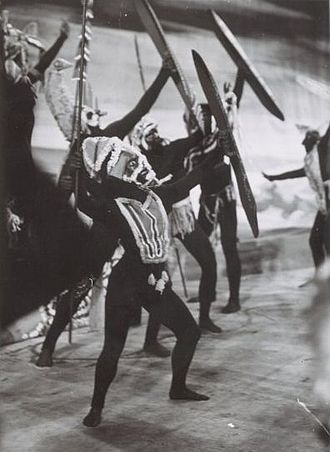Difference between revisions of "AY Honors/Aboriginal Lore/Answer Key"
| Line 1: | Line 1: | ||
| − | '' | + | :''For the frog of the same name see, [[Corroboree frog]].'' |
| + | [[Image:Corroborree.jpg|right|thumb|A [[ballet]] performance based on the Corroboree]] | ||
| + | In the northwest of Australia, ''corroboree'' is a generic word to define theatrical practices as different from ceremony. Whether it be public or private, ceremony is for invited guests. There are other generic words to describe traditional public performances: ''juju'' and ''kobbakobba'' for example. In the Pilbara, corroborees are ''yanda'' or ''jalarra''. Across the Kimberley the word ''junba'' is often used to refer to a range of genres. Corroboree and ceremony are strongly connected but different. In the 1930s Adolphus Elkin wrote of a public pan-Aboriginal dancing "tradition of individual gifts, skill, and ownership" as distinct from the customary practices of appropriate elders guiding initiation and other ritual practices (Elkin 1938:299). Corroborees are open performances in which everyone may participate taking into consideration that the songs and dances are highly structured requiring a great deal of knowledge and skill to perform. ''Corroboree'' is a generic word to explain different genres of performance which in the northwest of Australia include balga, wangga, lirrga, junba, ilma and many more. Throughout Australia the word ''corroboree'' embraces songs, dances, rallies and meetings of various kinds. In the past a corroboree has been inclusive of sporting events and other forms of skill display. It is an appropriated English word that has been reappropriated to explain a practice that is different to ceremony and more widely inclusive than theatre or opera. | ||
| − | + | ==See also== | |
| + | *[[Australian Aboriginal mythology]] | ||
| − | + | ==External link== | |
| + | *[http://indigenousaustralia.frogandtoad.com.au/cultural.html Introduction to Aboriginal culture] | ||
| − | + | [[Category:Australian Aboriginal culture]] | |
| − | + | [[Category:Australian Aboriginal terms]] | |
| − | + | [[Category:Dance in Australia]] | |
| − | + | [[sv:Corroboree]] | |
| − | |||
| − | |||
| − | |||
| − | |||
| − | |||
| − | |||
| − | |||
| − | |||
| − | |||
| − | |||
| − | |||
| − | |||
| − | |||
| − | [[ | ||
| − | |||
| − | |||
| − | |||
| − | + | {{IndigenousAustralia-stub}} | |
| − | + | hi | |
| − | |||
| − | |||
| − | |||
| − | |||
| − | |||
| − | |||
| − | |||
| − | |||
| − | |||
| − | |||
| − | |||
| − | |||
| − | |||
Revision as of 03:34, 21 August 2006
- For the frog of the same name see, Corroboree frog.

In the northwest of Australia, corroboree is a generic word to define theatrical practices as different from ceremony. Whether it be public or private, ceremony is for invited guests. There are other generic words to describe traditional public performances: juju and kobbakobba for example. In the Pilbara, corroborees are yanda or jalarra. Across the Kimberley the word junba is often used to refer to a range of genres. Corroboree and ceremony are strongly connected but different. In the 1930s Adolphus Elkin wrote of a public pan-Aboriginal dancing "tradition of individual gifts, skill, and ownership" as distinct from the customary practices of appropriate elders guiding initiation and other ritual practices (Elkin 1938:299). Corroborees are open performances in which everyone may participate taking into consideration that the songs and dances are highly structured requiring a great deal of knowledge and skill to perform. Corroboree is a generic word to explain different genres of performance which in the northwest of Australia include balga, wangga, lirrga, junba, ilma and many more. Throughout Australia the word corroboree embraces songs, dances, rallies and meetings of various kinds. In the past a corroboree has been inclusive of sporting events and other forms of skill display. It is an appropriated English word that has been reappropriated to explain a practice that is different to ceremony and more widely inclusive than theatre or opera.
